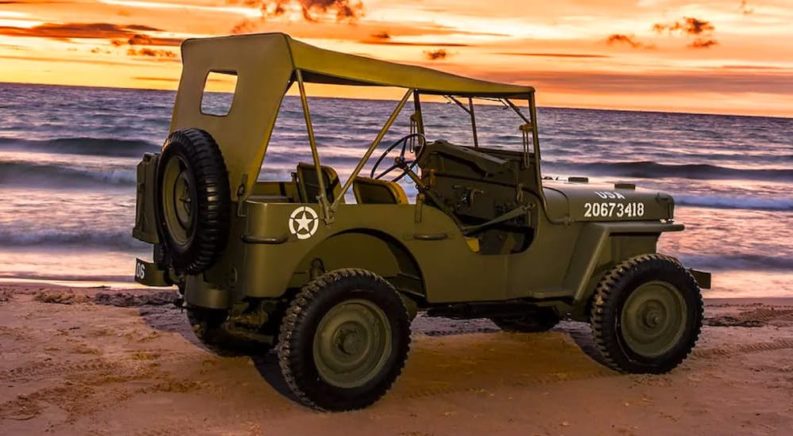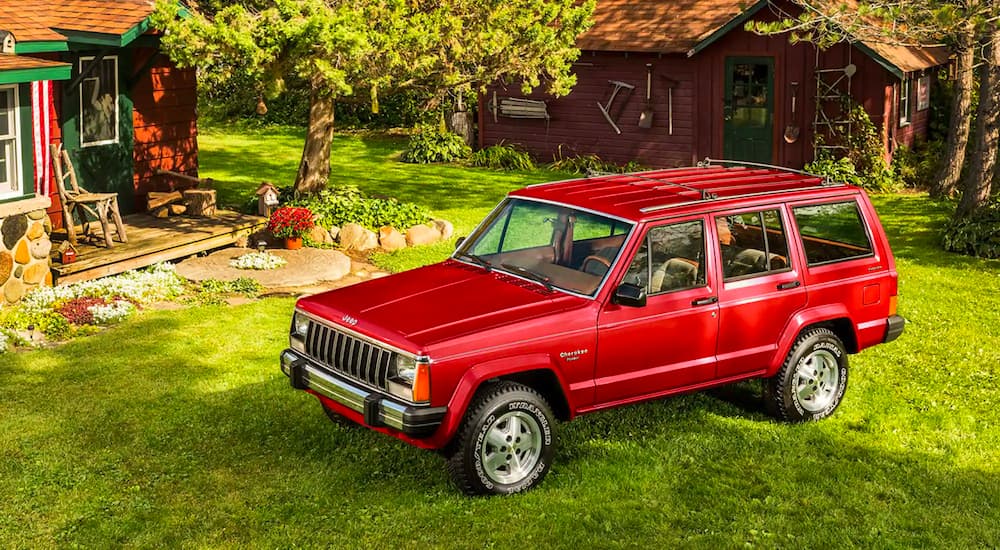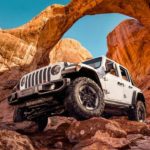In 2018 it was announced that the Jeep Gladiator pickup truck would be returning for the 2020 model year, after 32 years of being off the market. Some may find it hard to believe that so much time has passed since the Gladiator initially disappeared, but time flies, and here we are. But the Gladiator is far from the only truck ever built by Jeep, so let’s take a stroll through history and stop to look at Jeep trucks throughout the years. By the end, you just might want to head over to the nearest used truck dealership and take one of these old boys for a ride… especially the Honcho.
The 1940s
In 1940, a beautiful baby named Jeep was born. Well, actually not quite – in 1940, the United States Army reached out to 135 car manufacturers with an opportunity to develop a new vehicle suited to army needs. The Army only received three responses: Willys, Ford, and Bantam. These three companies worked together to make the first Jeep. Designing what they called the “Quad,” named it for its 4×4 technology, they produced a vehicle that would continue to develop its technology and change the course of military history in the heat of the Second World War.
With the end of the war in 1945, Willys-Overland began producing civilian vehicles. First was the CJ, which was designed to serve as a replacement to farm workhorses, as it was able to do the work of two large draft horses (I suppose you would say the CJ had two horsepower). This vehicle greatly increased efficiency in farming, doing jobs much more quickly than animals could. But the CJ still felt a lot like Jeep’s military vehicles (in fact, “CJ” stood for “Civilian Jeep”), and this was hardly a truck.
After debuting its first station wagon (which was also America’s first all-steel station wagon, just for your information), Jeep released a truck fit for the “modern farmer.” Now, this truck did not have a real name – it was simply known as the “Willys Jeep Truck,” but having a wheelbase of 118-inches, it was a major innovation for the Jeep brand. The truck gave the option of pickup or stake bed as well as the option of a chassis cab design, and it was well ahead of its time in offering four-wheel drive.
Willys-Overland made a strong first impression in the 1940s, which propelled them into continued success in the 1950s.
The 1950s
In the year 1950, Willys-Overland trademarked the word “Jeep.” Shortly thereafter, in 1953, Willys-Overland was sold and became Kaiser Jeep. With the new name came a new kind of truck: the Forward-Control series.
These trucks were odd-looking with their flat appearance and a nose that protruded out further than it seems proper due to their cab-over-engine design. Interestingly enough, these ingenious trucks were built atop the CJ-5 chassis, so Kaiser Jeep was building off of a preexisting design – a smart economic decision on their part. Despite their odd appearance and reused chassis, these trucks were very effective vehicles with an 18-foot turning radius and low, easily loadable bed. The advertisements for the Forward-Control series read, “More cargo space! On less wheelbase! And goes ‘anyplace’!”
That says it all. Once again, Jeep had changed the world of farming.
The 1960s
The 1960s saw major innovations for the Jeep brand; after producing a delivery van for mailmen and ice-cream trucks, Jeep focused predominantly on its new Wagoneer model and on improving its trucks. Oh boy, was the 1960s a decade for Jeep trucks.
In 1962 Jeep introduced the Gladiator pickup truck for the 1963 model year… little did they know they would be re-introducing it almost sixty years later. The full-size Gladiator pickup truck shared the platform, powertrain, and front-end styling of the newly popular Wagoneer station wagon.
The Gladiator offered plenty of desirable features, including two engine options in the Hi-Torque 6 and Vigilante V-8, in addition to the Turbo-Hydra-Matic automatic transmission. The J-2000 and J-3000 models were joined by the J-4000 in 1969, which offered yet more improvements. Most notably among these improvements was a camper edition which could mount a whole camper on the body of the truck with 3,930-pound of payload capacity, making it a good vehicle for family camping adventures.
But the Gladiator name would soon be going away…
The 1970s
The 1970s brought a new era for Jeep when Kaiser Jeep sold out to American Motors (AMC) in 1970. This was a decade focused on recreational vehicles.
The name Gladiator was done away with in 1971, but Jeep’s truck line remained in production as the J-series until 1987. With the Gladiator name gone, Jeep focused its efforts on the J-10 pickup truck line, which birthed the Golden Eagle, the Honcho, and the 10-4 trims. All of these trucks, from the cab forward, shared a body with the Wagoneer and the Cherokee. The 10-4 was a special truck, wowing the world with its option of a CB radio (factory-installed, of course).
The Honcho Golden Eagle truly embodied the 1970s by offering a stylish ride complete with gold stripping on the tailgate, bedside, and fenders. If only we could climb into those Levi denim seats, grab hold of the sport steering wheel, and take those spoker wheels for a spin today.
The 1980s
The early 1980s came with demands for more room than the CJ-5 and CJ-7 could provide, so AMC responded by producing the CJ-8 Scrambler pickup, which featured a 103-inch wheelbase with an overhanging bed, allowing for more cargo space. This Scrambler came in both hardtop and softtop varieties and was a favorite of President Ronald Reagan. Interestingly enough, U.S. Postal workers in Alaska were provided with Scramblers to complete their rounds. Despite these two big-time endorsements, the Scrambler was not a popular model in its day. It has, however, become a hot commodity for collectors in more recent years.
While the Scrambler wasn’t a huge commercial success, Jeep knocked it out of the park with another model. The 1984 Cherokee almost single-handedly started the modern SUV craze, and the closely related 1986 Comanche pickup truck became a popular alternative for drivers who needed a bit more utility. Still, Jeep’s success wasn’t enough to keep AMC’s otherwise lackluster product line afloat. Eventually, Chrysler stepped in, purchasing AMC and making Jeep a part of its new Jeep/Eagle Division.
The 1990s-2010s
In 1992, Chrysler ended production of the Comanche so as not to overshadow its Dodge Dakota pickup, putting to rest the Jeep truck line, which had lasted for 35 years. The company spent the 1990s focused on its development of luxury SUVs, a pursuit that continues to this day. Ah, how sentimental the iconic 1990s Jeep grill seems now. Jeep said a fine farewell to the Wagoneer model and, in its stead, said hello to the Grand Cherokee in 1993. In 1998, just in time for the new millennium, Daimler-Benz merged with Chrysler (including the Jeep Brand) in a $36 billion deal.
Yes, that’s $36 BILLION.
The newly-merged DaimlerChrysler put pickups to the side in the 2000s, continuing to focus primarily on luxury SUVs along with new models of the Wrangler. These efforts paid off, however, as a number of new Jeep vehicles hit the market during this time, and Chrysler continued to focus on Jeep SUVs after it regained independence in 2007. This certainly built the anticipation for what was to come…
The 2020s
Ah, now we have come full circle, back to the present day.
Yes, the Gladiator is back on the market as of the 2020 model year. Think not, dear reader, that Jeep simply tossed an old car back into the sales lot; on the contrary, its reintroduction blew up the market, as the Gladiator has been given a major-league makeover. The strong, sturdy, classic-yet-modern appearance of the new Gladiator, along with its top-of-the-line interior, cutting-edge technology (including an 8.4-inch touchscreen and Uconnect), and its groundbreaking off-road technology (might I point out the forward-facing TrailCam), made the 2020 Gladiator a profound checkpoint in Jeep history.
If that wasn’t enough, the Jeep brand has entered uncharted territory (literally) with the introduction of the Gladiator Mojave – Jeep’s first (and so far only) Desert Rated vehicle. It’s time to play.
Bringin’ it Home
Well, that was a nice trip down memory lane. So often, we let the world drag us around, and while we hear about new car models coming out year after year, we don’t stop to look at how far we’ve come. Jeep has been one of the leading automotive brands since its birth in 1940, and its history certainly reflects not only a significant piece of the automobile industry but also a significant piece of American culture.




